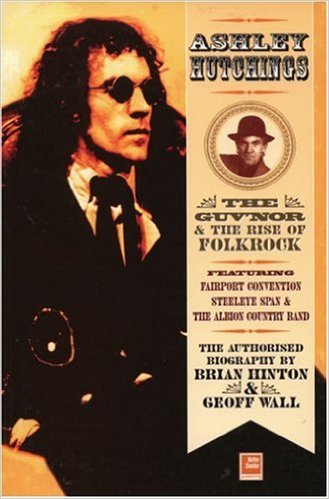 To some of us the subject of this book is, if not God, at least the musical equivalent to the pope. Name a group you like and have followed over the years, and there is a fair chance that Mr. Hutchings was there to start it, or at least influence the starting of it. He is in one way or another responsible for a very large number of the records in my collection, and yes, we are certainly talking three figures, here.
To some of us the subject of this book is, if not God, at least the musical equivalent to the pope. Name a group you like and have followed over the years, and there is a fair chance that Mr. Hutchings was there to start it, or at least influence the starting of it. He is in one way or another responsible for a very large number of the records in my collection, and yes, we are certainly talking three figures, here.
This biography by Hinton and Wall takes us from the early days in Muswell Hill, when the foundations of Fairport Convention were laid, up to that sad day in 1973 when Ashley quit the music business to become the local postman of his village, Etchingham. The authors have interviewed crowds of people, of course including the man himself, read newspaper articles and reviews, and listened to bootleg tapes of concerts in what must be described as a labour of love. No one in his or her right mind would dig this deep if not seriously attracted to what he or she is writing about.
To many of the addicted a lot will have been known before, but even for the most fanatical the book includes new things. You may have known that it was Tim Hart, not Ashley Hutchings, who was the driving force behind getting Martin Carthy into Steeleye Span Mark II, but did you know that this betrayed a promise made between the members of Mark I that the group would disband and the name not be used again if anyone from the original line-up left? Or that Hutchings was already a member of Mr. Fox when the call came for the reform?
There is also the story about Hutchings asking the others to rejoin Fairport Convention after they had found his replacement, a story all but Hutchings himself seem to have forgotten. Or about Albion Country Band Mark III having to beg for a chance to play the gigs booked for an earlier incarnation of the band. Not to mention about how the Guvínor pulled the plug on his bandmates when they started playing old rock ‘n’ roll-songs as encores at a London gig. Well, in this book you find the truth, the whole truth and, hopefully, nothing but the truth.
Hinton and Wall describe everything in great detail. Often they have dug out different versions of what really happened from the different people involved. Of course they let you know what went on in the studios where all this glorious music was recorded, not to mention the rehearsal retreats the groups used, and sometimes they take you through whole gigs, commenting on what was played and how it was played.
But at the heart of the story is the search for Englishness and the importance of the song. The authors show how Hutchings’ infatuation with English music grew, with the main seed sown during the making of Liege & Lief, even though his astonishing finds from the Cecil Sharp House archives were sometimes dismissed by Sandy Denny with “oh, that one, I’ve sung it for years.” It was this love of first folk music and later English folk music that made Hutchings start Steeleye Span and the different Albion Bands, and carried him through the Morris On and Complete Dancing Master projects.
And all the time the song, or the tune, is there at the centre. Hutchings feels no need to show off as a musician, he is there to bring the song to the listener. Not in any of his groups has there been a place for flashy technical musicians without a feel for the music itself. Or to quote him from the book, “That idea of virtuoso bass players bores me to tears. I’m a song man and I’m an ideas man.”
Hinton and Wall deserve a lot of credit for bringing this story to us. For anyone interested in any of the groups Hutchings has been involved with, this will serve as a bible, showing where it all started. But there are a few things missing from making it the “definitive work.” First of all, it lacks a proper discography. In the text, the authors deal with every record Hutchings played on during 1967-1973, but to have all the details collected in an appendix would have been a great help.
I would also very much have appreciated some sort of time line, with crucial dates like important concerts, official release dates of records and so on, included. Sometimes the authors jump to and fro chronologically, and if you are not already familiar with what happened it can become a bit confusing. They have also a tendency to use the same quotes more than once, in different parts of the book, something I put down to a lack of editing.
But having said that, I would not even suggest you abstain from reading it. For anyone interested in the roots of folk rock it is a must, up there together with Clinton Heylin’s No More Sad Refrains about Sandy Denny, and Patrick Humphries’ Meet on the Ledge about early Fairport Convention. So enjoy it! I surely did. And I sincerely hope there will be a Part II, starting the day Hutchings stopped working for the Royal Mail and resumed his musical career.
(Helter Skelter, 2002)
